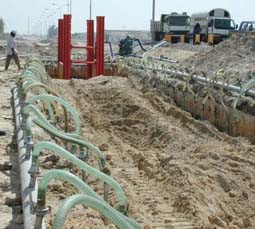This document specification deals with the general requirements for the Dewatering to keep excavations and pits dry, and to prevent damage to the buildings due to hydrostatic pressure. Work of this section shall be considered as Specialist Work and to be conducted by specialist party only. The applicable standard for this work is BS 9301.
The contractor shall submit a Water Control/Dewatering plan for review and approval no longer than 14 days after contract is awarded. The plan shall indicate the methods and techniques to be used for control of water (both surface runoff and groundwater) during work and the intended discharge points and facilities.
A basis for the approval of a dewatering Subcontractor will be the detailed methodology, and a demonstrated successful historical track record of the proponent, as assessed by consultant.
Protection of Site
Groundwater lowering shall be accomplished by such measures as perimetric and internal drains or pumped sumps extending sufficiently deep below the bottom of the excavation, and/or by well points or other suitable measures, as necessary. The selected method shall not have any adverse effect on the adjacent existing structures or the condition of the in situ soils to remain in place.
Disposal of Water
The dewatering contractor shall dispose of all water encountered in the earthwork operations so as not to damage property or create a nuisance or health menace. The contractor shall use a suitable technique as necessary to keep the construction area free from water until construction is completed.
Dewatering Requirements
Dewatering works shall comply with the requirements of BS 9301. The Contractor shall arrange for the rapid dispersal of water shed onto the earthworks or completed formation, or which enters the earthworks from any source.
Where the bulk or local excavation will extend below the groundwater table, measures shall be taken to lower the groundwater table to at least 0.5m below the excavation level until foundations are constructed and area is backfilled. Lowering of the water table shall be carried out from a level of not less than 0.5m below the excavation bottom so that at no time shall there be a positive hydraulic gradient into the excavation. This is to prevent loosening of the sand below the formation level caused by seepage into the excavation. Obtain consultant approval prior to stopping water depletion and removal of the dewatering system.
The contractor shall construct and maintain a temporary drainage and dewatering system during the course of clearing, grubbing, stripping and grading operations. The dewatering contractor shall design the temporary drainage and dewatering system to control storm water runoff and groundwater and shall submit the plan to consultant and obtain its approval before beginning work.
Establish and maintain temporary drainage ditches and other diversions outside excavations limits to convey rain water and water removed from excavations to collection or run-off areas. Do not use trench excavations as temporary drainage ditches.
Lowering of the groundwater level by pumping from the bottom of the excavation shall not be allowed. Where pounding of water occurs at the bottom of the excavation, the water shall be removed by gravity drainage to the perimetric or internal drains, or to pumped sumps.
Discover more from Project Management 123
Subscribe to get the latest posts sent to your email.